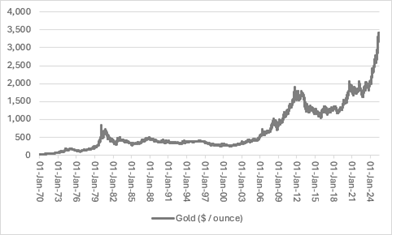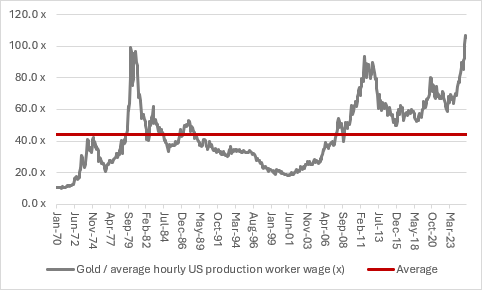
Gold bugs will be beside themselves after the precious metal’s 44% gain in dollar terms over the past year, but the more investors who buy in, the more of a consensus position it becomes, and the more of a consensus position it becomes, the fewer incremental buyers there are to drive up the price.
True believers will continue to warn of the dangers of debt, inflation and geopolitics. Others may at least think about a portfolio rebalancing to ensure they do not become over exposed.

Source: LSEG Refinitiv data
The trick then is how to assess fair value for the commodity, and whether there may be a level at which point it is sensible to lock in a profit.
The all-in-sustained cost (AISC) of production can perhaps help to gauge what the downside may be. This is around $1,400 to $1,500 an ounce for major producers such as Newmont or Barrick Mining.
But that does not help to judge any possible upside. Moreover, gold is inert, so there are no earnings, and it generates no cash, so there is no yield.
Those issues support Warren Buffett’s view that the precious metal has no role in portfolios, but gold has been money since time immemorial, and the latest rounds of central bank stockpiling implies this latter view still holds currency at the highest level.
Can the average worker still afford gold?
One crude way to assess ‘fair value’ for gold may be to measure how much metal a pay packet can buy. If bullion moves beyond the reach of the worker, that could at least crimp jewellery demand and one source of incremental buying.
Consistent wage data with real longevity is hard to find, but the US Federal Reserve offers nearly sixty years of figures for ‘production and non-supervisory employees.’
Before US President Nixon took America off the Gold Standard and smashed up the Bretton Woods monetary system in August 1971, it took a blue-collar American worker 12 hours to earn enough to buy an ounce of gold. That figure peaked at 97 times in late 1980 and 94 times in 2011. In this context, the current score of 105 hours could be seen as ominous for gold affordability, since the best cure for high prices is high prices – they stoke supply, depress demand, prompt searches for substitutes or all three.

Source: LSEG Refinitiv data, FRED - St. Louis Federal Reserve database
Gold bugs will counter by saying that inflation (and central bank money printing to cover monstrous government debts) can drag wages along for the ride, so they may not budge, especially as the metal’s gains are still pale compared to those of the inflation-wracked 1970s, when uncertainty in the Middle East was also a key global issue.
Investing in picks and shovels
Gold miners’ share prices have lagged that of gold and so gold mining equities may be an option, as they should start to generate plentiful profits and copious cash flow, if gold prices stay elevated and they suffer no meteorological, geological, political or regulatory mishaps (admittedly, that is a big ‘if’ in some cases and some jurisdictions, as Barrick Mining will attest).
Equally, it may be no coincidence that other commodity prices are starting to motor, particularly in the case of that look cheap relative to gold.
Since 1970, one ounce of gold has on average bought 17 to 18 barrels of oil. It currently buys 49 barrels. Since 1970, one ounce of gold has on average bought 60 ounces of silver. It currently buys nearly 91 ounces. Since 1970, one tonne of gold has on average bought nearly 5,700 tonnes of copper. It currently just over 10,700 tonnes.
How do raw materials fit into a portfolio?
These historic, price-relative trading ranges offer no guarantees for the future at all. But those investors who fear inflation may like to maintain a bias to raw materials, relative to ‘paper’ ones like cash and bonds but diversify their exposure to ‘real’ assets beyond gold.
Those portfolio builders who fear a slowdown, recession or even debt deflation may take the entirely opposite view.
At least investors can judge current market thinking by using the gold-to-copper relationship in particular.
The stronger gold is relative to copper, the greater the worries about inflation and central bank loss of control. The stronger copper is relative to gold, the more upbeat markets may feel on the economy and corporate earnings.
Ways to help you invest your money
Put your money to work with our range of investment accounts. Choose from ISAs, pensions, and more.
Let us give you a hand choosing investments. From managed funds to favourite picks, we’re here to help.
Our investment experts share their knowledge on how to keep your money working hard.
Related content
- Mon, 30/06/2025 - 13:29
- Thu, 26/06/2025 - 14:35
- Thu, 26/06/2025 - 11:50
- Tue, 24/06/2025 - 12:50
- Fri, 20/06/2025 - 10:20

